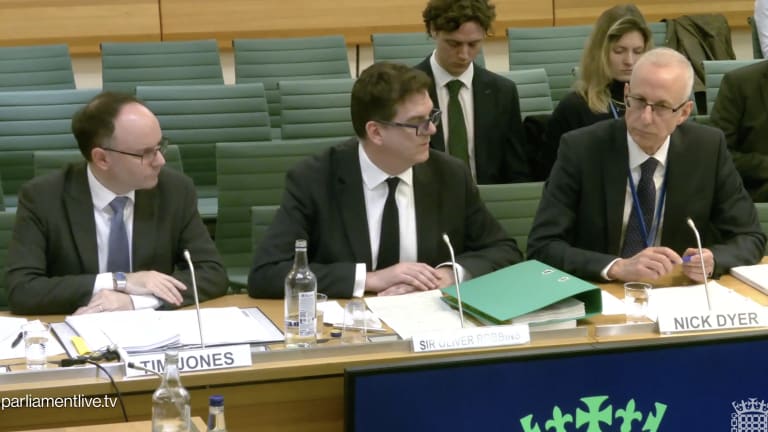The UK has changed how it calculates the aid budget — so is that good?
Allowing the country's aid budget to fluctuate along with national income has ups and downs.
The U.K. government announced a change to the way the aid budget would be calculated last week: It will no longer be adjusted for changes in gross national income. It’s a seemingly small and technical change but it could have a big impact on U.K. aid — for better or worse. While it will make the size of the aid budget much more predictable and reduce the management burden, aid advocates fear it amounts to a “stealth cut” worth hundreds of millions of pounds per year. For years, the U.K. aid budget has been calculated as a percentage of GNI, based on a United Nations target for wealthy countries to spend 0.7% on official development assistance, or ODA. The U.K. enshrined that target in law back in 2015, although — amid tough economic conditions and a crumbling political consensus — ambitions have been reduced in recent years to 0.5% and now just 0.3%. There’s a logic behind tying aid spending to GNI: It means countries pay an amount proportionate to what they can afford. The specific figure of 0.7% was determined back in the 1970s, based on how much money it was thought that lower-income countries needed to achieve desirable growth rates, although some researchers now consider it to be outdated. And it’s responsive to economic changes — when a country’s economy is doing well, it contributes more; when it’s doing poorly, it pays out less. But that responsiveness also comes with a major problem: While budgets are ideally set before the year begins, GNI isn’t known until after it ends. To deal with this problem, the United Kingdom has historically set its aid budget based on GNI forecasts, and then adjusted it throughout the year based on how the economy was actually performing. This led to unpredictable last-minute changes in the budget. Adding to these complications, the U.K. ODA budget is spent by several departments — and sometimes these departments spend more or less than expected during the year, particularly the Home Office which spends a significant amount of the budget on supporting refugees and asylum-seekers arriving in the U.K. To accommodate these variables, the Foreign, Commonwealth & Development Office was assigned to serve as the “spender and saver of last resort” of the U.K. aid budget. In other words, if the government found it needed to spend extra money at the end of the year to hit its GNI-based aid target, FCDO was the department that got to spend it; but if it found that too much had been spent by the end of the year, FCDO was responsible for finding the savings. When the Independent Commission on Aid Impact — the U.K.’s official aid watchdog — reviewed the 0.7% spending target back in 2020, one former minister described the considerable managerial challenge as like “landing a helicopter on a handkerchief.” Even in the good years, when FCDO is handed an unexpected windfall at the end of the year, it’s difficult to spend money well that quickly. Last year, for example, it found itself with a whopping £540 million top-up at the end of the year, almost all of which was given to British International Investment — the U.K.’s development finance institution — in what Sarah Champion, chair of the International Development Committee, described as a “last-minute panic.” Rescheduling multilateral contributions around the end of the year is another common trick used to hit the target. ICAI described the process as “a considerable managerial challenge” that sucked up resources and created risks that money might not be spent as effectively as possible. This was the reasoning presented by the government when it announced the change to how the budget would be determined. “The UK now sets the ODA budget based on GNI forecasts at an SR [Spending Review] and these will not be adjusted for GNI fluctuations,” development minister Jenny Chapman wrote in a letter to Champion. “As a result of this change, the FCDO no longer holds the ODA ‘spender and saver of last resort’ role, meaning the FCDO is no longer required to adjust budgets to hit a calendar year spending commitment. “This is a significant and positive change to the way the FCDO manages its ODA budget. The FCDO will no longer be automatically exposed to the volatility of GNI fluctuations or ODA spending by other departments, including demand-driven in-donor refugee costs, thereby increasing the predictability of our budgets and allowing us to plan with more certainty.” Why, then, are aid advocates worried about the news? That’s mainly because — while the aid budget can in theory both benefit and suffer from these fluctuations — it’s more likely to benefit, in part because of the effect of inflation on the GNI metric during the year. The change also comes amid an assault on the aid budget that has seen it cut from 0.7% of GNI to just 0.3% within a few years. Given other recent decisions — including immediate cuts announced at the same time as the GNI change — the aid community’s trust in the government is low, and the decision is being interpreted accordingly. For Gideon Rabinowitz, director of policy and advocacy at Bond, the U.K. network of aid NGOs, it amounts to “a stealth cut to the UK aid budget.” Rabinowitz noted that the government’s GNI forecasts “have been consistently revised upwards over the last two years.” “If the March 2023 OBR [Office for Budget Responsibility] projections for GNI for 2023/24-2025/26 were used to fix the ODA budget over this period, then UK ODA would have been around £1 billion less in each of these three years than the level currently estimated to be required to meet the 0.5% of GNI target,” he wrote. Similarly, he wrote, with the government working hard to reduce the amount spent on in-donor refugee costs, FCDO stood to benefit from potential underspends by the Home Office in coming years — meaning more money for international development spending. That will no longer be the case. According to newly released estimates of 2024 spending, in-donor refugee costs ate up 20% of ODA spending in 2024, compared to 28% in 2023. This may, in fact, be the bigger issue, according to Ian Mitchell, a senior policy fellow at the Center for Global Development, because refugee spending is a more volatile figure than GNI. The best way to resolve this would be to count refugee spending outside of the aid budget — something aid advocates have been asking for for years, but to no avail. In its 2020 review, ICAI also suggested several ways to handle the unpredictability of the budget that might pose a lesser risk to development spending. The government could introduce a “tolerance range” into the target, allowing a small amount of variation above or below 0.7%, it suggested; or it could set the target as a three-year rolling average to allow for yearly fluctuations. These tactics are used by some other ODA donors. Alternatively, it could give FCDO a “spending floor” — a minimum amount it could spend each year — which would give it some certainty while still allowing it to benefit from upward revisions if the economy performed well or other departments spent less than expected. After all, the 0.7% target was always intended as a minimum. The challenge of meeting it has been exacerbated by the fact that U.K. administrations have consistently interpreted it as both a minimum and a maximum. Given these realities, Mitchell sees the decision as positive in terms of giving FCDO a predictable budget. Nonetheless, it does risk leaving it short changed — and at a time when it doesn’t have much to spare.
The U.K. government announced a change to the way the aid budget would be calculated last week: It will no longer be adjusted for changes in gross national income. It’s a seemingly small and technical change but it could have a big impact on U.K. aid — for better or worse.
While it will make the size of the aid budget much more predictable and reduce the management burden, aid advocates fear it amounts to a “stealth cut” worth hundreds of millions of pounds per year.
For years, the U.K. aid budget has been calculated as a percentage of GNI, based on a United Nations target for wealthy countries to spend 0.7% on official development assistance, or ODA. The U.K. enshrined that target in law back in 2015, although — amid tough economic conditions and a crumbling political consensus — ambitions have been reduced in recent years to 0.5% and now just 0.3%.
This story is forDevex Promembers
Unlock this story now with a 15-day free trial of Devex Pro.
With a Devex Pro subscription you'll get access to deeper analysis and exclusive insights from our reporters and analysts.
Start my free trialRequest a group subscription Printing articles to share with others is a breach of our terms and conditions and copyright policy. Please use the sharing options on the left side of the article. Devex Pro members may share up to 10 articles per month using the Pro share tool ( ).
Jessica Abrahams is a former editor of Devex Pro. She helped to oversee news, features, data analysis, events, and newsletters for Devex Pro members. Before that, she served as deputy news editor and as an associate editor, with a particular focus on Europe. She has also worked as a writer, researcher, and editor for Prospect magazine, The Telegraph, and Bloomberg News, among other outlets. Based in London, Jessica holds graduate degrees in journalism from City University London and in international relations from Institut Barcelona d’Estudis Internacionals.








